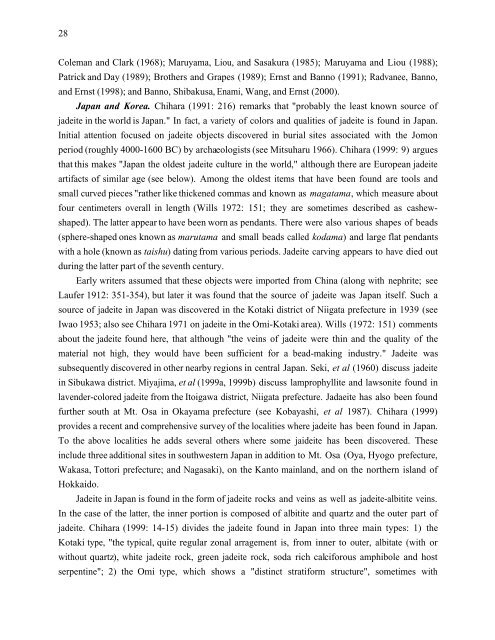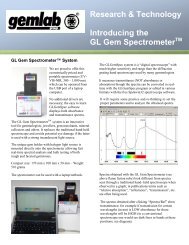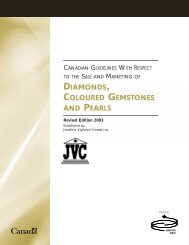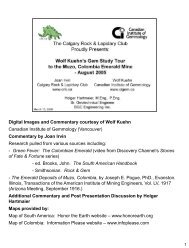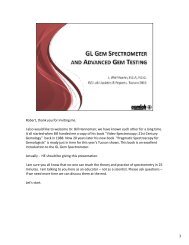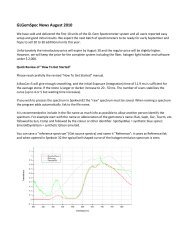JADEITE - Canadian Institute of Gemmology
JADEITE - Canadian Institute of Gemmology
JADEITE - Canadian Institute of Gemmology
Create successful ePaper yourself
Turn your PDF publications into a flip-book with our unique Google optimized e-Paper software.
28<br />
Coleman and Clark (1968); Maruyama, Liou, and Sasakura (1985); Maruyama and Liou (1988);<br />
Patrick and Day (1989); Brothers and Grapes (1989); Ernst and Banno (1991); Radvanee, Banno,<br />
and Ernst (1998); and Banno, Shibakusa, Enami, Wang, and Ernst (2000).<br />
Japan and Korea. Chihara (1991: 216) remarks that "probably the least known source <strong>of</strong><br />
jadeite in the world is Japan." In fact, a variety <strong>of</strong> colors and qualities <strong>of</strong> jadeite is found in Japan.<br />
Initial attention focused on jadeite objects discovered in burial sites associated with the Jomon<br />
period (roughly 4000-1600 BC) by archaeologists (see Mitsuharu 1966). Chihara (1999: 9) argues<br />
that this makes "Japan the oldest jadeite culture in the world," although there are European jadeite<br />
artifacts <strong>of</strong> similar age (see below). Among the oldest items that have been found are tools and<br />
small curved pieces "rather like thickened commas and known as magatama, which measure about<br />
four centimeters overall in length (Wills 1972: 151; they are sometimes described as cashew-<br />
shaped). The latter appear to have been worn as pendants. There were also various shapes <strong>of</strong> beads<br />
(sphere-shaped ones known as marutama and small beads called kodama) and large flat pendants<br />
with a hole (known as taishu) dating from various periods. Jadeite carving appears to have died out<br />
during the latter part <strong>of</strong> the seventh century.<br />
Early writers assumed that these objects were imported from China (along with nephrite; see<br />
Laufer 1912: 351-354), but later it was found that the source <strong>of</strong> jadeite was Japan itself. Such a<br />
source <strong>of</strong> jadeite in Japan was discovered in the Kotaki district <strong>of</strong> Niigata prefecture in 1939 (see<br />
Iwao 1953; also see Chihara 1971 on jadeite in the Omi-Kotaki area). Wills (1972: 151) comments<br />
about the jadeite found here, that although "the veins <strong>of</strong> jadeite were thin and the quality <strong>of</strong> the<br />
material not high, they would have been sufficient for a bead-making industry." Jadeite was<br />
subsequently discovered in other nearby regions in central Japan. Seki, et al (1960) discuss jadeite<br />
in Sibukawa district. Miyajima, et al (1999a, 1999b) discuss lamprophyllite and lawsonite found in<br />
lavender-colored jadeite from the Itoigawa district, Niigata prefecture. Jadaeite has also been found<br />
further south at Mt. Osa in Okayama prefecture (see Kobayashi, et al 1987). Chihara (1999)<br />
provides a recent and comprehensive survey <strong>of</strong> the localities where jadeite has been found in Japan.<br />
To the above localities he adds several others where some jaideite has been discovered. These<br />
include three additional sites in southwestern Japan in addition to Mt. Osa (Oya, Hyogo prefecture,<br />
Wakasa, Tottori prefecture; and Nagasaki), on the Kanto mainland, and on the northern island <strong>of</strong><br />
Hokkaido.<br />
Jadeite in Japan is found in the form <strong>of</strong> jadeite rocks and veins as well as jadeite-albitite veins.<br />
In the case <strong>of</strong> the latter, the inner portion is composed <strong>of</strong> albitite and quartz and the outer part <strong>of</strong><br />
jadeite. Chihara (1999: 14-15) divides the jadeite found in Japan into three main types: 1) the<br />
Kotaki type, "the typical, quite regular zonal arragement is, from inner to outer, albitate (with or<br />
without quartz), white jadeite rock, green jadeite rock, soda rich calciforous amphibole and host<br />
serpentine"; 2) the Omi type, which shows a "distinct stratiform structure", sometimes with


